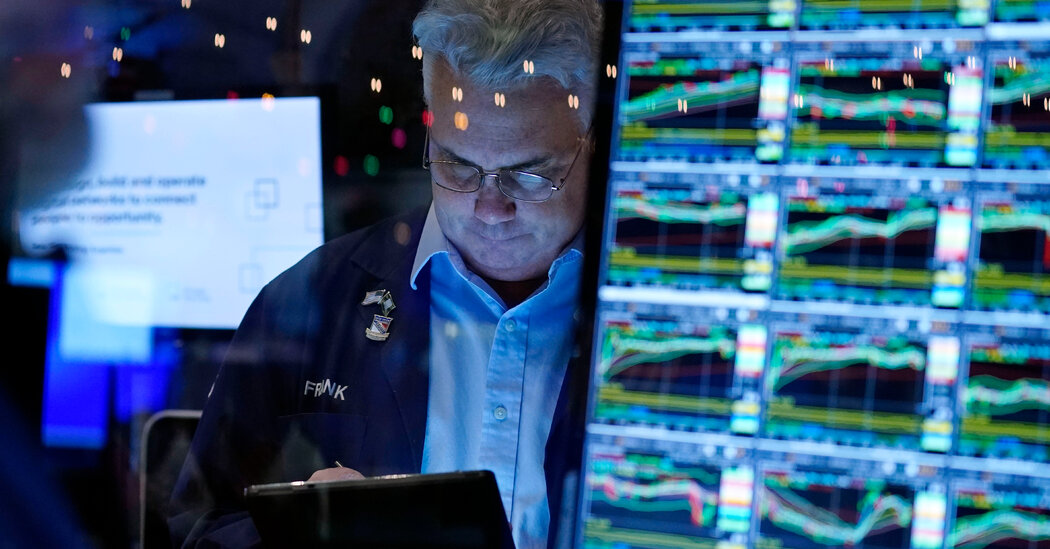
Inflation Rising at Fastest Pace in Nearly 40 Years, New Data Shows


+
14
%
+
12
Inflation
+
10
+
8
+
6
+4.9%
without food
and energy
+
4
+
2
Year-over-year change in the
Consumer Price Index
–
2
’70
’80
’90
’00
’10
’20

+
14
%
Inflation
+
12
+
10
+
8
+
6
+4.9%
without food
and energy
+
4
+
2
Year-over-year change in the Consumer Price Index
–
2
’70
’75
’80
’85
’90
’95
’00
’05
’10
’15
’20
Inflation jumped to the highest level in nearly 40 years, fresh data released on Friday showed, as supply chain disruptions, rapid consumer demand and rising housing costs combined to fuel the strongest inflationary burst in a generation.
The rising costs spell trouble for officials at the Federal Reserve and the White House, who are trying to calibrate policy at a moment when the labor market has yet to completely heal from the pandemic, but the risk that price increases could become more lasting is increasing.
The Consumer Price Index climbed by 6.8 percent in the year through November, the data showed, the fastest pace since 1982. After stripping out food and fuel, which can move around a lot from month to month, inflation climbed by 4.9 percent.
Prices were up 0.8 percent from October, according to the report. That’s slightly slower than the prior monthly increase, but still an unusually rapid pace.
The question is what happens next. Fed officials have become increasingly concerned about price increases — both because the uptick has lasted longer than expected and because it shows signs of broadening to areas less affected by the pandemic.
Earlier this year, prices increases were concentrated in goods. Used cars and couches were in demand as the pandemic changed people’s lifestyles, but factories around the world struggled to keep up with the surge in buying, in part because shutdowns tied to the virus upended production. Shipping routes and ports also became clogged as demand followed an atypical pattern, with too many U.S.-bound goods trying to leave Asia in particular.
Those disruptions were expected to be temporary. Instead, they have lasted for months, as demand for goods remains strong and because the virus continues to upend production.
As pandemic quirks persist, inflationary pressures are also broadening. That includes rental prices, which have surged after an initial slackening during the pandemic, helping to push up overall price gains. It’s a worrying development for the Fed as it considers its next policy steps.
“Generally, the higher prices we’re seeing are related to the supply-and-demand imbalances that can be traced directly back to the pandemic and the reopening of the economy, but it’s also the case that price increases have spread much more broadly in the recent few months,” Jerome H. Powell, the Fed chair, said during congressional testimony late last month. “I think the risk of higher inflation has increased.”
Fed officials are closely watching what happens with wages — and with consumer inflation expectations — as they try to gauge when and how much inflation will fade. But they are also starting to acknowledge that they might have to react to rising prices.
Mr. Powell signaled last week that the Fed, which began cutting back on economic support last month, will discuss speeding up that process at its Dec. 14-15 meeting. Economists expect central bankers to announce a plan to slow down their monthly purchases fast enough that the program ends several months earlier, putting Fed officials in a position to raise their policy interest rate, their more traditional and more powerful tool.
Raising that rate would make debt of all kinds, from mortgages to car and business loans, more expensive. That would likely slow spending and hiring, cooling off demand and weighing down buoyant housing costs. The combination could help to put a lid on price gains.
But it could also leave the country with a less competitive labor market. That could be bad if the millions of people who remain out of the labor market compared to before the pandemic — many of them because of child-care issues and other virus-tied concerns — decide to embark on a job hunt.
The Labor Department’s announcement on Friday that the Consumer Price Index rose 0.8 percent in November and 6.8 percent from the year before is the latest sign of rapid price increases eroding President Biden’s approval ratings on the economy and threatening the expansive economic and climate legislation he is trying to push through Congress by the end of the year.
Voters and a crucial Democrat in the Senate, Joe Manchin III of West Virginia, have become increasingly concerned with the rising inflation that now ranks as America’s fastest annual price growth in four decades. A string of recent polls show inflation now ranks as the top economic concern nationwide, a product of rising costs for gasoline, food and a variety of goods that Americans have bought in droves as the country emerges from the pandemic recession.
Mr. Manchin is a centrist who looms as the most likely Democrat to vote against Mr. Biden’s $2.2 trillion legislation, which the president is trying to pass along party lines, given Republicans have no intention of voting for the bill. Mr. Biden will need every Democrat in the Senate to support the measure for it to pass. Mr. Manchin has in recent days repeated his fear that the spending in the bill, which includes initiatives to fight climate change and invest in children, parents and workers, could exacerbate price increases further — a claim that administration officials and Mr. Biden say is unfounded.
The president has attempted in recent weeks to balance his efforts to cast the recovery as strong — citing job gains, falling unemployment claims, nominal wage growth and the fastest economic growth since the mid-1980s — with acknowledgment that inflation has hurt American families’ wallets. And he has stressed the actions his administration has taken to unclog supply chains that are contributing to price increases.
“Even as we’ve built this incredible jobs and economic recovery,” he said in a news release on Thursday, nodding toward Friday’s expected inflation report, “we have struggled — like virtually every other developed economy dealing with the pandemic — with rising prices and supply chain woes. I have taken strong, aggressive measures to combat these challenges.”
Mr. Biden’s aides have said throughout the year that the expect the current bout of inflation to fade quickly, as supply chain issues work themselves out and the world continues to emerge from the pandemic. Those predictions have frequently proven overly optimistic. But administration officials made another round of them this week ahead of the Labor Department release, saying they expected the drivers of inflation, like rising prices for used cars, to prove temporary and the rate of inflation to fall sharply in the first half of 2022.
Administration officials also say they already see signs that other main drivers of price increases, like gasoline, are cooling off. Energy prices were up 33 percent from a year ago in the November report, and gasoline prices were up 58 percent. But the cost of a gallon at the pump began to fall in recent weeks, and so has the cost of natural gas.
Mr. Biden said on Thursday that the expected report on energy price inflation “does not reflect today’s reality, and it does not reflect the expected price decreases in the weeks and months ahead, such as in the auto market.”
Image
The U.S. stock market has been on a run, with the S&P 500 up nearly 4 percent so far this week, and more than 25 percent for the year. Fears about the Omicron variant of the coronavirus quickly faded, with stocks regaining lost ground.
This makes some market watchers nervous, the DealBook newsletter reports, because of a metric that suggests that stock prices may be too high given the level of corporate earnings and rising inflation.
The S&P 500 now has a real earnings yield — the inflation-adjusted ratio of earnings per share to the stock price — approaching negative 3 percent, the lowest since 1947, Bank of America equity strategists led by Savita Subramanian wrote in a recent note to clients. Negative yields are rare and often precede a stock market slump, the analysts wrote.
A low earnings yield means that corporate profits are not keeping up with stock prices. And because real yields subtract inflation from the measure, a negative real earnings yield means that a company, based on its stock price, is not generating enough profits to keep up with rising prices. (Using October’s inflation number, Tesla’s real earnings yield is negative 5.2 percent.)
The last time the S&P 500 had a negative real earnings yield, the Bank of America analysts said, was in 2000, before the tech bubble burst. It also happened twice during the stagflation of the 1970s and ’80s. This year, the S&P 500’s real earnings yield turned negative months ago, but it really sank recently as inflation has marched higher.
Besides a bear market, there are two ways a negative earnings yield can turn positive:
-
First, inflation would have to drop significantly, which some economists think is possible.
-
Second, at a time when wages are rising and supply issues are interfering with plans, corporate profits could accelerate faster than expected.
After the initial shock of the pandemic, stocks have shrugged off negative news and set a series of records. But the more that analysts consider the numbers, the more they worry that the gravity-defying rise may not last much longer. (Stocks fell on Thursday.)
That said, “we live in a world where real negative rates are almost acceptable as a norm,” Ms. Subramanian noted.
Image
BuzzFeed’s first week on the stock market went from bad to worse Thursday, when its stock lost nearly a quarter of its value.
Its shares dropped 23.6 percent, to close at $5.87, and at that price they are now down 31 percent from where they closed Monday, when it made its debut as a public company.
BuzzFeed, which is known for both its catchy lists and its traditional journalism, went public by merging with a shell corporation known as a special purpose acquisition company, or SPAC, a route onto the stock market that was popular earlier this year but has since lost favor among investors.
BuzzFeed raised far less money from the merger than it had expected to after many investors in the SPAC asked for their money back. BuzzFeed’s leadership had hoped that going public would make it easier for it to acquire other digital media companies. But doing so will be much harder after its fund-raising came up short and if its stock remains depressed.
At it current share price, BuzzFeed, which bought HuffPost last year, has a market value of $775 million.
BuzzFeed’s difficult first week will send a chill through the boardrooms of other digital media companies that have been hoping to go public or raise new money.
The speed and depth of the decline in BuzzFeed’s stock may in part be because there is a small number of shares available to trade. It may not take much selling to push the share price down; conversely, a small amount of buying would send it higher.
BuzzFeed appears to have sufficient cash on hand to finance its business. It recently raised $150 million from selling debt securities. In the nine months through the end of September, it lost $16 million, a small improvement from a loss of $21 million in the same period of 2020.
Image
Daimler’s car and truck divisions concluded an amicable divorce on Friday when shares in Daimler Truck began trading separately on the Frankfurt stock exchange.
The separation of Mercedes-Benz, the luxury carmaker, from Daimler Truck, which owns Freightliner in the United States, signaled the end of an era not only for Daimler but also the German economy.
The spinoff, announced in February, was the final chapter in a transition that began in the 1990s, when Daimler was a sprawling conglomerate that also made trains and passenger aircraft. Along with other industrial empires like Siemens, Daimler has been forced to jettison excess baggage to remain competitive.
For car and truck makers, the need to ditch unwieldy corporate structures has become even more urgent as they try to survive the shift to emission-free propulsion. One justification for the spinoff is that it will allow Daimler Truck’s managers to make decisions more quickly.
Daimler Truck is betting on hydrogen fuel cells for long-haul trucks, in contrast to competitors like Scania that favor batteries. It is not yet clear which technology will prevail.
A few decades ago, many German companies operated on the principle that bigger was better. That might have made sense when capital was harder to come by, said Martin Daum, the chief executive of Daimler Truck, because the more profitable parts of a conglomerate could generate cash for struggling units.
“We had globally very inefficient capital markets,” Mr. Daum said in an interview. “That supported the buildup of conglomerates.”
“Today, every business that has a compelling idea can raise money,” he said.
Whether Daimler Truck has compelling ideas will now be put to the test. The shares opened Friday at 28 euros (about $31.60) and rose as much as 8.5 percent, valuing the company at about $27 billion.
The new company is the largest truck maker in the United States by way of its Freightliner brand. Globally, Daimler Truck is also the largest maker of buses. Its other brands include Mercedes-Benz trucks and buses sold primarily in Europe and Fuso trucks sold in Asia.
Daimler Truck and Mercedes-Benz luxury cars will remain closely connected. Daimler, the parent company of Mercedes, will retain a 35 percent stake in Daimler Truck. The remaining shares will be distributed to Daimler shareholders.
BNP Paribas, Citigroup and Goldman Sachs are serving as listing agents for the spinoff.
Source: https://www.nytimes.com/live/2021/12/10/business/inflation-cpi-stock-market-news

















